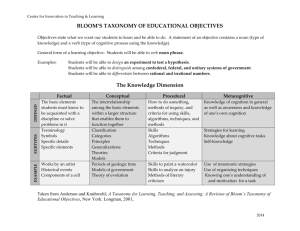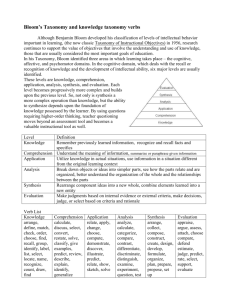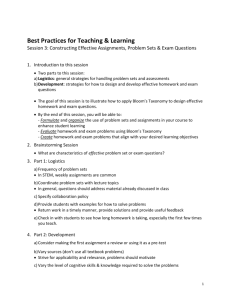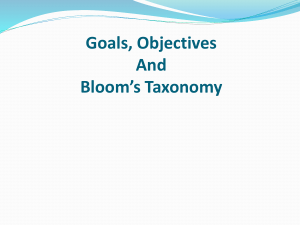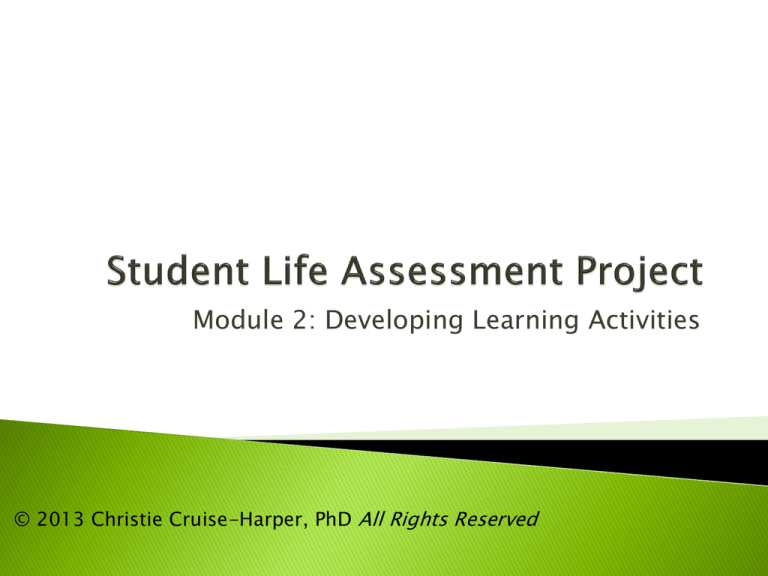
Module 2: Developing Learning Activities
© 2013 Christie Cruise-Harper, PhD All Rights Reserved
The purpose of this module is to assist you
with developing or refining learning activities
based on the learning outcomes you created
in module 1 for the program/service you plan
to assess for the 2013 – 2014 academic year.
Department
Office of Multicultural Programs
Personal Counseling
Health and Wellness
Program
Multicultural Scholars Program/Dean’s
Award Program
Mandated Substance Abuse Assessment
Program
HEROs Program
Campus Ministry and Community
Service
Student Involvement
KLILV Sophomore Colloquium
Athletics
SAAC or Champs
Residence Life
Resident Assistant Program
CAB/MSG/CSI
Student Life/Associate Dean of Students Habitat for Humanity
Learning activities serve two primary functions:
◦ To Inform: Learning activities that inform introduce
the supporting knowledge that students need in order
to perform the competency.
◦ To practice: Learning activities that cause practice
require learners to interact with the content,
processing it, and applying it so that they store what
they have learned in long term memory.
Oregon State Department of Education
The first step in developing meaningful
learning activities is reviewing the learning
outcomes of the program/service you plan to
assess.
The assessment template you received with the first module
should not only contain your mission/goals, but should now have
your program/service learning outcomes.
Intended
Learners
Action
Verb 1
Program/
Service
Action
Verb 2
1
who
will be
able to
2
who
will be
able to
3
who
will be
able to
4
who
will be
able to
Intended
Outcome
In module 1 you learned that Bloom’s Taxonomy provides a
classification of levels of intellectual behavior.
Higher
Cognitive
Levels
Lower
Cognitive
Levels
Each of the levels of Bloom’s Taxonomy requires a different
degree of engagement, processing and synthesis.
Cognitive Level
Cognitive Process
Knowledge
Recalling or recognizing knowledge, facts or
concepts
Comprehension
Understanding the meaning of information
and materials
Application
Using information and materials to solve new
problems or respond to concrete situations
that have a single or best answer
Analysis
Decomposing material into their component
parts so they can be examined and
understood
Synthesis
Using new and creative applications of prior
knowledge and skills
Evaluation
Judging value of materials based on personal
values/opinions or definite criteria. Concerned
with evaluating material to determine if it
fulfills given purpose
Each of your learning outcomes should
contain an action verb 1 and 2.
Find action verb 2 in each of your learning
outcomes.
Find the cognitive level where your action
verb 2 is located in the Bloom’s Taxonomy
Action Verb list you received in module 1.
Note: Learning outcomes should represent
cognitive levels that increase from lower to
higher.
Knowledge
Comprehension
Application
Analysis
Synthesis
Evaluation
Arrange
Classify
Apply
Analyze
Arrange
Appraise
Define
Describe
Choose
Appraise
Assemble
Argue
Duplicate
Discuss
Demonstrate
Calculate
Collect
Assess
Label
Explain
Dramatize
Categorize
Compose
Attach
List
Express
Employ
Compare
Construct
Choose
Memorize
Identify
Illustrate
Contrast
Create
Compare
Name
Indicate
Interpret
Criticize
Design
Estimate
Order
Locate
Operate
Differentiate
Formulate
Evaluate
Once you have located your action verb 2 for
each of your learning outcomes and have
determined their designation in Bloom’s
Taxonomy, you are ready to begin developing
learning activities to assist students in
achieving the established learning outcomes.
What activity will help my
students achieve the established
learning outcome?
Bloom’s
Taxonomy
Cognitive Process
Action Verbs
Potential Learning
Activity
Knowledge
Recalling or recognizing
knowledge, facts or concepts
Arrange, Define, List
Lecture, readings, web
information
Comprehension
Understanding the meaning of
information and materials
Explain, Discuss, Describe
Readings, discussions, PairShare
Application
Using information and materials to
solve new problems or respond to
concrete situations that have a
single or best answer
Apply, Demonstrate,
Illustrate
Demonstration problemsolving/scenarios, small group
demonstrations/peer review,
demonstrate a procedure
Analysis
Decomposing material into their
component parts so they can be
examined and understood
Distinguish, Analyze,
Compare
Simulations/role play,
compare/contrast projects,
discussion, labs
Synthesis
Using new and creative
applications of prior knowledge
and skills
Arrange, Design, Develop
Informational interviews,
develop a unique plan for a
specific purpose, research
Evaluation
Judging value of materials based
on personal values/opinions or
definite criteria. Concerned with
evaluating material to determine if
it fulfills given purpose
Assess, Defend, Interpret
Debates, small group
discussions, demonstrate
process for evaluating
research reports based on
criteria
In module 1 you developed learning
outcomes. This module has assisted you with
aligning the learning outcomes with the
learning activities for the program/service
you plan to assess. Module 3 will assist you
with choosing the appropriate assessment
tools.
Learning Outcome
Learning Activity
Assessment
What should your students be
able to do?
What activity will help your
students achieve the learning
outcome?
How will you assess whether
students have achieved the
learning outcome?
Module 1
Module 2
Module 3
Module 1
Module 2
Module 3
Module 1
Module 2
Module 3
Morton, M. (2013). Aligning learning outcomes, learning
activities, & assessments in the blended learning
environment. Centre for Teaching Excellence. University
of Waterloo.
Oregon Department of Education. (2013). Chapter
8:Designing learning activities. Retrieved on June 14,
2013 from http://www.ode.state.or.us/home/.
University of Central Florida. (2013). Faculty Center for
Teaching and Learning: Bloom’s Taxonomy. Retrieved on
June 14, 2013 from
http://www.fctl.ucf.edu/teachingandlearningresources/
coursedesign/bloomstaxonomy/


